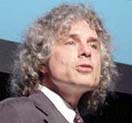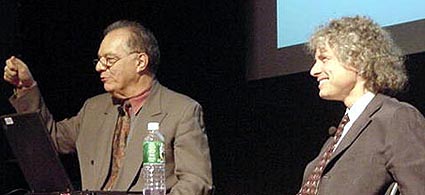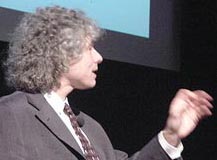| pinker's
farewell |
||||
|
Thursday,
Sept. 25, 2003 Abstract Legendary
professor and author Steven
Pinker reflects on his research on language, cognition and
creativity and on his career as one of MIT's most admired teachers. Steven Pinker was appointed Johnstone Family Professor of Psychology at Harvard University this fall, after twenty years in MIT's Department of Brain and Cognitive Sciences. One of America's most famous public intellectuals, he is the author of many essays and books, including The Language Instinct (1994) and The Blank Slate: The Modern Denial of Human Nature (2002). Moderator: Samuel Jay Keyser is the Peter de Florez Professor Emeritus in Linguistics and Special Assistant to the Chancellor at MIT. A webcast of Pinker's Farewell is now available.
STEVEN
PINKER began with recollections of his early career at MIT
as a postdoctoral fellow at the Center for Cognitive Science.
He recalled his involvement in the center's Lexicon Project,
which included theoretical work on how the meaning of a word
governs its usage in a sentence. The project helped him solve
a paradox in language development that had troubled him for
years. In general cases, the verb dictates the structure of a sentence. One of the things a child has to learn is what verbs go with what sentence structures. For example, consider the pair of sentences: John
loaded hay onto the wagon. In the first sentence, the verb has the direct object "hay," followed by the prepositional object "wagon." In the second construction, the direct object becomes the prepositional object, and vice versa. In English, there are sixty to seventy verbs that allow you to make this alternation, another example being: John splashed the wall with water; John splashed water onto the wall. With this pattern, it would behoove a child to extract this regularity and use it to generalize to new verbs. Children are not restricted to parroting the sentences they hear. Generalizations are essential to language acquisition, because language is an infinite system with no limit to the number of thoughts you can express. However, there are exceptions to the generalization of making these flips. For instance, you could say: Amy poured water into the glass; but saying: Amy poured the glass with water sounds incorrect, even though its meaning is clear. How could this sound odd given the generalization? Although children make these errors, evidence shows that most parents do not correct them on sentence form. How children grow up to find these sentences ungrammatical was unclear. The resolution to this paradox came from ideas that emerged from the Lexicon project. Two rules were identified. The first rule is concerned with how a situation is conceptualized. For example, when you load hay onto a wagon, the object you are affecting depends on how you construe the situation. You can be affecting the hay by moving it, or holistically affecting the wagon by making it full. Language captures those alternative construes of the same event in the sentences above. The second rule maps the affected entity onto the position of direct object. In the case of the sentence: John loaded hay onto the wagon, "hay" is the direct object because it is primarily affected. Considering these rules, you begin to see why some verbs go into the alternation, while others do not. Languages dictate what kind of situations can undergo a conceptual shift by dividing the world of actions according to geometry and force. In English, verbs of simultaneous contact and motion (such as brush, smear, rub, streak), as a class, all undergo the flip: Brush butter onto the turkey, brush the turkey with butter. Verbs of imparting force causing ballistic motion (such as splash or splatter) also undergo the alternation. But of the verbs enabling gravity to cause motion (such as pour, drip, dump, spill), none permit the alternation. This is the same with other verbs of mediated attachment, when there is another force between the object and the destination (for instance pin, fasten, attach). Therefore, you can "brush the turkey with butter," but you cannot "pour the turkey with butter." Speakers
cognitively decompose an event into the sequence of physical
events that underlie the meaning of each word. When you learn
a language, you must subdivide your verb classes very finely
according to this intuitive physics. For Pinker, this uncovered
a world of conceptual structure that could be revealed through
grammar.
QUESTION: Given that children at some point do make these errors, how do they get to the point of not making them? PINKER: Children make these errors sporadically; even adults make them. The errors aren't prohibited, but just sound a little odd. If you look at the number of such errors that children make, as a proportion of the number of opportunities to make them, it is very small. I think historically, a language changes when one of these classes is stretched, so that an event is easier to construe. When enough people hear it from one another, the language embraces the change. QUESTION: The lengths of the descriptions of the verb lists are as long as the lists themselves. What makes you think that children aren't just memorizing the lists? PINKER: First of all, there is a generalization tendency in language that shows it is not about memorizing lists. As for the lengthy descriptions, the features that language cares about tend to be universal, and are reused over many classes. Pinker next spoke of three great visionaries who were among his colleagues at MIT: David Marr, Marvin Minsky, and Noam Chomsky. David Marr was a scientist and professor in the Department of Psychology from 1977 to 1980. People were in awe of him, and some of his proposals were looked upon as dogma. Pinker's research on vision was influenced by Marr's work in shape recognition. The simplest mechanism for recognizing a shape would be to have a template: a stored representation that mimics the shape of the object. However, a template matching mechanism will make errors if the object is shifted, rotated, or presented in other variations. Yet these are things a human can recognize easily. Marr believed that shapes were defined on a coordinate system centered on the object itself. As a shape moves, the coordinate system moves with it, and the description of the shape remains invariant. This is in contrast to a viewer-centered reference frame, where the object is described with respect to the viewer's coordinate system. Pinker tested Marr's theory in a number of ways. In one experiment, people learned shapes that were too complex to be recognized by a simple feature. The shapes were learned in one orientation, but were presented in another orientation in a test to see how long it took people to name them. If Marr was correct in that humans had a representation of shape that was invariant across all orientations, a person should be equally fast at recognizing objects in all orientations. Alternatively, if humans were good at shape recognition because they memorized shapes at various orientations they have seen, then a person could faster identify an orientation he or she has seen before. Pinker found that Marr's prediction of orientation independence was only partly right. Subjects took a longer time in recognizing orientations they did not learn. However, when the shape was symmetrical, they recognized it equally as quickly in all orientations. It seemed that humans have an object-centered coordinate system that could be mapped directly on an object regardless of orientation, but only for one dimension at a time. Consider the shapes of a square and a diamond with 90-degree angles. In terms of Euclidean geometry, they are identical. Nonetheless, they have different names. This shows that the perception of shape is not just the process of matching templates, but also depends on the larger context that defines a coordinate system. Pinker next spoke of Marvin Minsky's influence. Minsky was a scientist, philosopher, and seer who helped to demystify intelligence in the 1950s. Minsky argued that people could make sense of thinking as a kind of computation. Finally, there was the influence of Noam Chomsky. Two of Chomsky's ideas were especially inspiring. First was the notion that the mind was a complex system composed of a number of faculties, including language. The other was the idea that the organization of the mind was innate, and that children were preprogrammed to learn language. Pinker's work tries to flesh out what exactly a child is born with in terms of a learning algorithm. Pinker differentiates his work from Chomsky's in a several ways. While Chomsky's analysis of language is more abstract, Pinker stays close to actual surface forms. Pinker says he differs from Chomsky on the larger question of where language fits in human nature. For Pinker, natural selection is the only process that can result in evolution of complex innate structures. A complete story of language asks what role it played in evolution, and what were the selective advantages in having complex grammar. Chomsky does not see it this way. In fact, over the years he has become rather hostile to the idea that language is a system designed for communication. He believes that language evolved for beauty, not for use. Chomsky's skepticism about evolution extends far enough to say that there is nothing about language that is particularly well adapted for communication. Chomsky's theory of human nature links his theories of language and politics, Pinker said. He believes that people have a spontaneous tendency to cooperate and create for the sheer sake of it without regard for reward or consequences. That is the deepest root of Chomsky's belief system. This leads his radical politics. It also leads to a conception of language that emphasizes creativity, but devalues the utility of language as a system of communication. It cannot be explained in terms of its beneficial consequences, which is the essence of natural selection. For Pinker, Chomsky's view is fascinating and beautiful, but very different from his own. Discussion: QUESTION: Why isn't there some middle ground on the development of language? Perhaps language was born as a method of expressing creativity, and by accident became important for communication, and then was passed on by natural selection. PINKER: Well, evolution has to work like that in the sense that the initial variation cannot be for anything. The reason why I wouldn't put it that way is that the system for expressing thought has enough complexity that it couldn't have arisen because of random mutation; it is too organized. There exists a reproductive benefit to striking bargains and exchanging know-how. It seems more plausible that the initial function was to communicate, and that sheer expression was a spandrel of communication, as opposed to the other way around. Another consideration is that language comes at a cost. Humans are the only mammals that cannot breathe and drink at the same time; we have a vocal tract that is adapted for language, and are at risk of choking whenever food passes over our trachea with some chance of being lodged in it. S. J. KEYSER: So could it be possible that the first language was sign language?
PINKER: It is not a crazy idea. In fact, it is an old idea that has been revisited by psychologist Michael Corballis in his book From Hand to Mouth, where he argues that gesture was an intermediate stage. This is something we cannot really know, but there is some circumstantial evidence in the fact that chimpanzees have hand gestures, or that sign language is so easy for children to acquire. Much language use involves a hybrid of speech and gesture; sometimes it is impossible not to use gesture. For example, how do you define the word "spiral"? QUESTION: You've mostly talked about the way children learn language. Does an adult learn language in a fundamentally different way? PINKER: That's a very good question. We know that adults are not as good at it as children. Adults are more likely to be saddled with an accent, as well as minor syntax and inflection mistakes that a native speaker would not make. This is probably because of a change in the plasticity of the brain that occurs with biological adulthood. Still, adults learning a second language do better than one would think, because they have a first language to fall back on. Much of learning a second language in adulthood is mentally translating from the first language. There are two reasons why I think that. One is that adults make errors in their second language that would be grammatical in their first language. The second reason is based on the study of deaf people acquiring sign language. There was a study that looked at two groups: people deafened in adulthood who subsequently learned sign language were compared to people who were deaf from birth, but were kept away from signing until adulthood. Of the two groups, the adults who learn sign language as a second language did better. QUESTION: I have a question about articulation. Most people don't have the vocabulary to express all the continuous and analog thoughts in their heads. How much is language binding, considering the fact that you have to express these continuous signals in your head with a finite basis of words in your vocabulary? PINKER: I wouldn't think of language as binding in the sense that it prevents you from thinking in certain ways, even if you had a smaller vocabulary. Although thought is so rich and analog, language does multiply the value of thinking, because you can acquire new concepts through communicating with other people. The way language changes also suggests that it doesn't confine us. I think that when there's something we want to express, we change the language, rather than being unable to think it. QUESTION: Is there an evolutionary explanation for why Chomsky is so romantic? PINKER: Perhaps not an evolutionary one. I think there are great themes in our intellectual tradition that differentiate thinkers, as well as people on the political left and right, who have different conceptions of human nature. The conventional alignment is that people on the right believe in a stronger conception of human nature, while people on the left embrace the idea of a blank slate. Chomsky was so radical because he upended that equation; he was firmly on the left, but was an innatist. QUESTION: What I gathered from your writings is that you seem to think most of the complexities of our language are unique to humans. Can you talk about why you think so? PINKER: Language abilities emerge spontaneously in any normal child in a natural human community, whereas the abilities of chimps are the results of human training pushing them to their limits. It is not a level playing field to begin with. Added to that is the fact that the ability of trained chimps to use sign language is extremely rudimentary. I don't think it is meaningful to ask whether other animals have language, because that is a semantic question of how broadly you want to define language. A better question would be whether other animal communication systems work according to the same principles as human language. The differences are rather extreme - the two main ones being our dependence on combinations as opposed to individual signs, which is the central importance of grammar; and our ability to refer to things independent of our immediate emotional states. QUESTION: One thing that frustrates me about cognitive science is how great thinkers can have such radically divergent ideas. Do you think that with the advent of technologies, there can be some strong non-trivial predictions that can be made in the future, that might distinguish some of these contradictory hypotheses? PINKER: Yes, definitely, I am an optimist in terms of trying to make ideas more testable and empirically responsive. In terms of how new techniques might further resolve this, functional neuroimaging might be one way, but I think genomic analysis might be more informative. There was a study published in Nature a year ago that was relevant to the issue of whether language was a target of natural selection. It was an analysis of a gene that was responsible for a speech disorder, and the results of the study support the idea of language as a target of natural selection.
--compiled by
Lilly Kam |
||||



